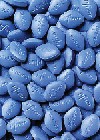 |
Best-corrected visual acuity is still 20/25+ O.D. and 20/20 O.S., but there is now a marked relative afferent pupillary defect O.S. He still demonstrates equal color perception between the two eyes, but there is now a 50% decrease in light sensitivity O.S.
Intraocular pressure is similar to his previous exam at 20mm Hg O.D. and 23mm Hg O.S. Dilated fundus exam reveals optic disc cupping of 0.2/0.2 O.U.similar to the prior exam. There are no glaucomatous changes to either disc, but there is marked pallor and atrophy of the left disc.
Analysis with the GDxVCC reveals loss of nerve fiber layer superiorly O.S., and automated visual fields show a corresponding defect in the inferior hemifield. You refer the patient for magnetic resonance imaging of the brain orbits and chiasm. The imaging shows no abnormalities. Serological testing also is normal.
The patient has no history of painful vision loss that suggests optic neuritis. You diagnose him with optic neuropathy, but there appears to be no identifiable cause. After all these tests, the patient says, Hey, doc, I dont know if this is important, but I forgot to tell you that Ive been taking Viagra since my last examination. That statement brings us to this months topic: ophthalmic sequelae of Viagra.
Viagra (sildenafil citrate, Pfizer) is an oral medication used to treat erectile dysfunction in men. Specifically, Viagra increases the bodys ability to achieve and maintain an erection. The medication comes in 25mg, 50mg and 100mg tablets.
 |
| This little blue pill and other drugs used to treat erectile dysfunction have been linked with NAAION. |
Sildenafil is a potent and selective inhibitor of cGMP-specific PDE5. Thus, cGMP can act longer upon smooth muscles of the cavernous callosum to prolong blood flow to the penis and enhance the erection.
Known Visual Effects
We already know that Viagra can induce transient color vision disturbances.1-4 Use of the drug may cause a perception of bluish haze or increased light sensitivity in some patients.1,3
Viagra inhibits PDE5, which is present in all vascular tissue. It also exerts a minor inhibitory action against PDE6, which is present exclusively in rod and cone photoreceptors.2 Inhibition of PDE6, which functions in visual transduction, can result in the above mentioned transient visual disturbances.1
Recent Visual Effects
There have recently been reports of a possible association between Viagra use and nonarteritic anterior ischemic optic neuropathy, or NAAION.5-10 NAAION typically presents as a painless, unilateral disturbance of vision. Patients with NAAION are older but not necessarily elderly; they generally are in the 55- to 65-year-old age group. Vascular disorders, such as hypertension, diabetes and/or atherosclerosis, often are present in these patients.11
Ophthalmoscopy in patients who have NAAION reveals disc edema, which may be diffuse or segmental.12,13 Disc hemorrhages are common, occurring in more than two-thirds of NAAION patients.12 Also, the optic disc is characteristically hyperemic, often displaying dilation of the overlying arterioles. The vasculopathic etiology is usually hypertension or diabetes, both of which are often accompanied by arteriolosclerosis.
A key diagnostic characteristic of NAAION: a small, crowded optic disc with minimal cupping in the contralateral eye. This disc at risk is a significant risk factor for the development of NAAION in predisposed individuals.12,14,15
While a clear association has been reported between Viagra use and NAAION, a causal relationship is difficult to prove. Patients who developed NAAION after taking Viagra had a disc at risk and arteriolosclerotic risk factors.6,7 The age range of NAAION patients also overlaps that of Viagra users. In one report, however, four of five patients who took Viagra and developed NAAION had no vascular risk factors for the condition.5 Also, it is hard to dispute the involvement of Viagra in NAAION given that the ischemic event occurs minutes to hours after ingestion of the drug.5,7
Viagra clearly can cause transient decreases in systolic and diastolic blood pressure and an array of minimal side effects due to the inhibition of other types of phosphodiesterase.16 So, Viagra-induced hypotension may be the precipitating factor in NAAION, especially in patients who have pre-existing risk factors.
Interestingly, though, while Viagra can enhance blood flow by relaxation of the smooth muscle, it appears to have no effect on ocular circulation. So, we cannot consider it to be protective against optic disc ischemia.17
Viagra is not the only erectile dysfunction drug linked with NAAION. Recent reports have also associated the erectile dysfunction drugs Cialis (tadalafil, Lilly ICOS) and Levitra (vardenafil hydrochloride, Schering-Plough and GlaxoSmithKline) with this condition. In July, the FDA approved updated labeling for all three drugs that now includes information on the possibility of vision loss.18
Because erectile dysfunction medications are popular, we must recognize the potential ocular complications of their use and counsel those patients who have vasculopathic risk factors on the potential danger associated with these medications.
1. Marmor MF, Kessler R. Sildenafil (Viagra) and ophthalmology. Surv Ophthalmol 1999;
Sep-Oct;44(2):153-62.
2. Laties A, Zrenner E. Viagra (sildenafil citrate) and ophthalmology. Prog Retin Eye Res 2002 Sep;21(5):485-506.
3. Jagle H, Jagle C, Serey L, et al. Visual short-term effects of Viagra: double-blind study in healthy young subjects. Am J Ophthalmol 2004 May;137(5):842-9.
4. Bischoff E. Potency, selectivity, and consequences of nonselectivity of PDE inhibition. Int J Impot Res 2004 Jun;16 Suppl 1:S11-4.
5. Pomeranz HD, Smith KH, Hart WM Jr, Egan RA. Sildenafil-associated nonarteritic anterior ischemic optic neuropathy. Ophthalmology 2002 Mar;109(3):584-7.
6. Boshier A, Pambakian N, Shakir SA. A case of nonarteritic ischemic optic neuropathy (NAION) in a male patient taking sildenafil. Int J Clin Pharmacol Ther 2002 Sep;40(9):422-3.
7. Pomeranz HD, Bhavsar AR. Nonarteritic ischemic optic neuropathy developing soon after use of sildenafil (Viagra): a report of seven new cases. J Neuroophthalmol 2005 Mar;25(1):9-13.
8. Cunningham AV, Smith KH. Anterior ischemic optic neuropathy associated with Viagra. J Neuroophthalmol 2001 Mar;21(1):22-5.
9. Gruhn N, Fledelius HC. Unilateral optic neuropathy associated with sildenafil intake. Acta Ophthalmol Scand 2005 Feb;83(1):131-2.
10. Egan R., Pomeranz H. Sildenafil (Viagra) associated anterior ischemic optic neuropathy. Arch Ophthalmol 2000 Feb;118(2):291-2.
11. Sowka, JW, Gurwood, AS, Kabat AG. Non-arteritic anterior ischemic optic neuropathy. In: Sowka JW, Gurwood, AS, Kabat AG. 2005 Handbook of Ocular Disease Management. Rev Optom 2005 March 15;142(3 Suppl):43A-45A.
12. Gray LG. NAION: Diagnosing in the negative. Rev Optom 2000 June 15;137(6):83-98.
13. Hayreh SS. Anterior ischemic optic neuropathy. Differentiation of arteritic from non-arteritic type and its management. Eye 1990;4(Part 1):25-41.
14. Burde RM. Optic disk risk factors for nonarteritic ischemic optic neuropathy. Am J Ophthalmol 1993 Dec 15;116(6):759-64.
15. Arnold AC. Pathogenesis of nonarteritic anterior ischemic optic neuropathy. J Neuroophthalmol 2003 Jun;23(2):157-63.
16. Krenzelok EP. Sildenafil: clinical toxicology profile. J Toxicol Clin Toxicol 2000;38(6):645-51.
17. Grunwald JE, Siu KK, Jacob SS, Dupont J. Effect of sildenafil citrate (Viagra) on the ocular
circulation. Am J Ophthalmol 2001 Jun;131(6):751-5.
18. U.S. Food and Drug Administration. FDA Statement: FDA Updates Labeling for Viagra, Cialis and Levitra for Rare Post-Marketing Reports of Eye Problems. www.fda.gov/bbs/topics/NEWS/2005/NEW01201.html.

